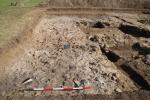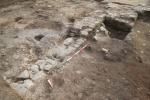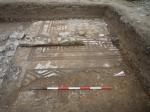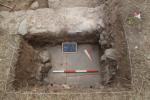Summary (English)
This was the third campaign of excavations in the quarter situated east of the southern stretch of the Cardo Maximus at Luni.
In the northern sector of Area 1000 the investigations concentrated in the area – originally interpreted as open – to the north and east of room 1 and now denominated room 2 (Fig. 1). The research aimed to check the characteristics of the craft-working installation that was set up in this part of the excavation area in about the mid 5th century A.D. and was partially excavated in previous seasons.
A stratigraphy formed by at least three different dumps was reached below the agricultural surface layers. All three were attributable to the same activity (Fig. 2). The layers in question, which ceramic finds date to the mid 6th century A.D., presented a substantial quantity of building materials including fragments from two floors, in opus signinum and opus spicatum. The latter was of particular interest as the classic spicatum bricks were replaced by various types of materials (roof tiles, bessales, other types of brick), cut to size to fit a floor of this style.
The described levels obliterated the floor levels and razed walls belonging to earlier structures, which, based on the previously excavated stratigraphy, are datable to the first half of the 5th century A.D. The final stretch of a pipe made of terracotta tubuli, which exited the small circular structure inside room 1, was identified north of the room. The pipe entered a quadrangular masonry-built vat with a floor of marble slabs (Fig. 4). This was probably in situ and part of a pre-existing structure (an impluvium?).
The eastern side of room 2 was delimited by a wall 60 cm wide (Fig. 5), probably built when the craft-working installation was created. It may be suggested, with due caution, that the latter was a fullonica.In the southern sector, the enlargement of the excavation area exposed a series of rooms, leading to an overall re-reading of the structures. Indeed, the plan of the rooms suggests the presence of a domus, which in later periods was restructured several times (Fig. 6).
Room 4, interpretable as an atrium, contained two large fragments of an opus scutulatum mosaic floor (Fig. 7), while the white and black floor mosaic in room 8 (the tablinum?) was preserved almost intact. The central design (about a quarter of which was uncovered) presented a vegetal motif of vine leaves. The exterior border was formed by a meander pattern, and a series of squares formed by broken lines, partially preserved on the west side, probably marked the passage from room 4 to room 8.The entire southern sector was then subjected to the systematic robbing of the walls for the recovery of the building materials. The stratigraphy relating to this intervention was almost exclusively made up of mortar, plaster fragments, small pieces of stone and a few pottery fragments. The presence of pottery datable to the first occupation phases in this area indicates that the robbing also involved the fill of the foundation trenches. The large quantity of painted plaster fragments, pieces of masonry relating to the actual plastering of the wall, and the complete absence of construction elements, suggests the earlier buildings were systematically dismantled following the removal of the wall plaster.
The fact that this stratification is present across almost all the rooms in the southern sector (rooms 4-8), also covering the later structures is of great interest. The destruction layer also covers the make up for mosaics in areas away from the walls, which makes it possible to propose that, at the time of the robbing, the mosaics already had large holes in them, evidence of an abandonment phase that had already began some time before.
- Simonetta Menchelli - Università degli Studi di Pisa Dipartimento di Civiltà e Forme del Sapere.
Director
- Stefano Genovesi – Università degli Studi di Pisa, Dipartimento di Civiltà e Forme del Sapere
Team
- A. Maccari
- R. Marcheschi- Università di Pisa Dipartimento di Civiltà e Forme del Sapere responsabile rilievo
- Paolo Sangriso – Università degli Studi di Pisa, Dipartimento di Civiltà e Forme del Sapere.
- S. Genovesi - Università degli Studi di Pisa
Research Body
- Università di Pisa Dipartimento di Civiltà e Forme del Sapere
Funding Body
- Università di Pisa Dipartimento di Civiltà e Forme del Sapere





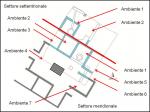
![Download [PDF]](/excavation/skins/fasti/images/results/download_sml.png)
